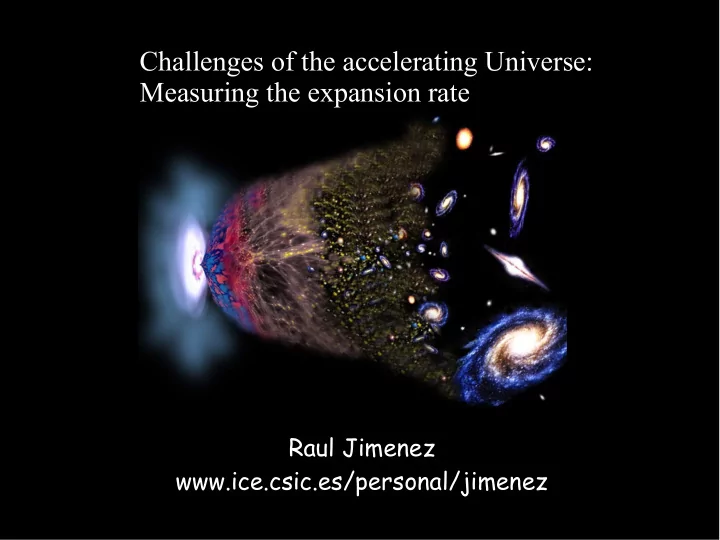

Challenges of the accelerating Universe: Measuring the expansion rate QuickTime ᆰ and a TIFF (LZW) decompressor are needed to see this picture. Raul Jimenez www.ice.csic.es/personal/jimenez
The basics Action describing the dynamics of the universe is: Consider quintessence a perfect fluid: Which has conservation law: For full treatment see Simon, Verde, RJ (2005)
with Dan Stern (JPL/Caltech) Marc Kamionkowski (Caltech) Licia Verde (Barcelona)
A Lesson from the past: Globular Cluster RELATIVE AGES “This method provides relative ages to a formal precision of 2-7%. We demonstrate that the calculated relative ages are independent of the choice of theoretical model.” (0812.4541)
Reconstruct w(z): RELATIVE GALAXY AGES At z=0 dz/dt gives Ho and we have SDSS galaxies: 1 dz = − H ( z ) + ( 1 z ) dt (Jimenez et al. 2003) The edge for z<0.2 (Jimenez et al. 2003) Similar trend found by Bernardi et al. (astro-ph/0509360) using alpha-enhanced models The value of H0
GDDS +high z radiogalaxies + Treu et al. 2000 sample From Simon, Verde, RJ (2005)
Multiple uses of H(z) A factor 5 improvement on universe transparency (Avgoustidis, Verde, RJ arXiv:0902.2006) Detection of aceleration/deceleration (Avgoustidis, Verde, RJ arXiv:0902.2006)
Multiple uses of H(z) Constraints on the mass and number of relativistic particles (de Bernardis et al. JCAP0803:020,2008 Figueroa, Verde, RJ JCAP0810:038,2008 ) and on the curvature
The importance of having high S/N spectra Spectra of SN Ia hosts may If you want to do radial BAOs help to tighten the H diagram you do need spectra Roig et al. (2009) Aubourg et al. (2008)
Recommend
More recommend